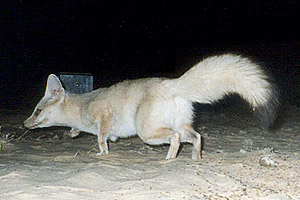Pale fox
Pale fox (Vulpes pallida )
The Pale Fox ( Vulpes pallida ) is a kind of genuine fox ( Vulpini ). It is widespread in sub-Saharan Africa in the semi-desert areas.
Features
The Pale Fox is similar to that occurring in southern Africa Kapfuchs. The legs and ears are quite long, the latter rounded at the tips. The ground color is pale beige, legs and occasionally the back are reddish brown. Bottom, face and ear insides are bright, sometimes almost white. In contrast to the approximately equal Rüppellfuchs (Vulpes ruepelli ) has the pale fox, a black tail tip. The dental formula is 3/3-1/1-4/4-2/3 = 42
He reached a shoulder height of 25 centimeters and a head-body length of 45 centimeters. Its body weight is about 2 to 3.6 kg.
Pale foxes are well adapted to the habitat. They tolerate well the dry season occurring in high heat and need little water. Liquid they probably win from the eaten fruits and prey. Without water, they do not come out though.
Distribution area
The distribution area of the Pale Fox is in the semi-desert areas of northern Africa south of the Sahara. It stretches from the Atlantic to the Red Sea, and roughly corresponds to the Sahel and the southern neighbor drier parts of the Geography Sudan. It includes parts of the states of Mauritania, Mali, Senegal, Gambia, Nigeria, Niger, Burkina Faso, Benin, Cameroon, Chad, Sudan and South Sudan, Ethiopia and Eritrea.
Way of life
The Pale fox inhabits dry savanna and semi-deserts and occasionally penetrates into real deserts before. Apparently he lives in small family groups consisting of a breeding pair and their offspring.
The nocturnal animals spend the day in self-dug burrows that can be up to 15 m long, going 2-3 m in depth, and is inhabited by several animals. A litter includes 3-4 puppies. The gestation period is 51-53 days. Striking is the well-developed molars are what allow conclusions on their food: they eat well mostly berries, melons and other parts of plants but also bodennistende birds, small animals and carrion.
System
Kapfuchs ( V. chama )
Bengalfuchs ( V. bengalensis )
Pale fox ( V. pallida )
Afghan fox ( V. cana )
Fennec fox ( V. zerda )
Kit Fox ( V. macrotis )
Arctic fox ( V. lagopus )
Steppe fox ( V. corsac )
Tibetan fox ( V. ferrilata )
Red fox ( V. vulpes)
Rüppellfuchs (v. rueppelli )
The first scientific description of the Pale fox comes from Philip Jacob Cretzschmar from the year 1827. Nowadays, it is classified together with eleven other species in the genus Vulpes. On the basis of morphological and molecular data, he was of Binninda - Emonds et al. 1999 in a joint group with the Kapfuchs ( V. chama ) and the Bengalfuchs ( V. bengalensis ) filed and the remaining species of foxes faced as a sister group.
In addition to the nominate Vulpes pallida pallida 5 subspecies are described, of which the lower 4 are recognized:
- Vulpes pallida cyrenaica
- Vulpes pallida sudab of Korbofan to Dongalo
- Vulpes pallida edwardsi Mali and Senegal
- Vulpes pallida harterti northern Nigeria to Air in Niger
- Vulpes pallida oertzeni Nigeria, northern Cameroon, Chad bisLybien in the north and the south Sudanese Darvoprovinz.
Threat and protection
The International Union for Conservation of Nature and Natural Resources ( IUCN) classified the species as " not at risk " ( Least concern ), as an acute threat for the stocks will not be accepted. It is pointed out that there is no detailed information on the population size, the size of the distribution area and the lack of threats to the total inventory, however, suggest no classification in a hazard category.









